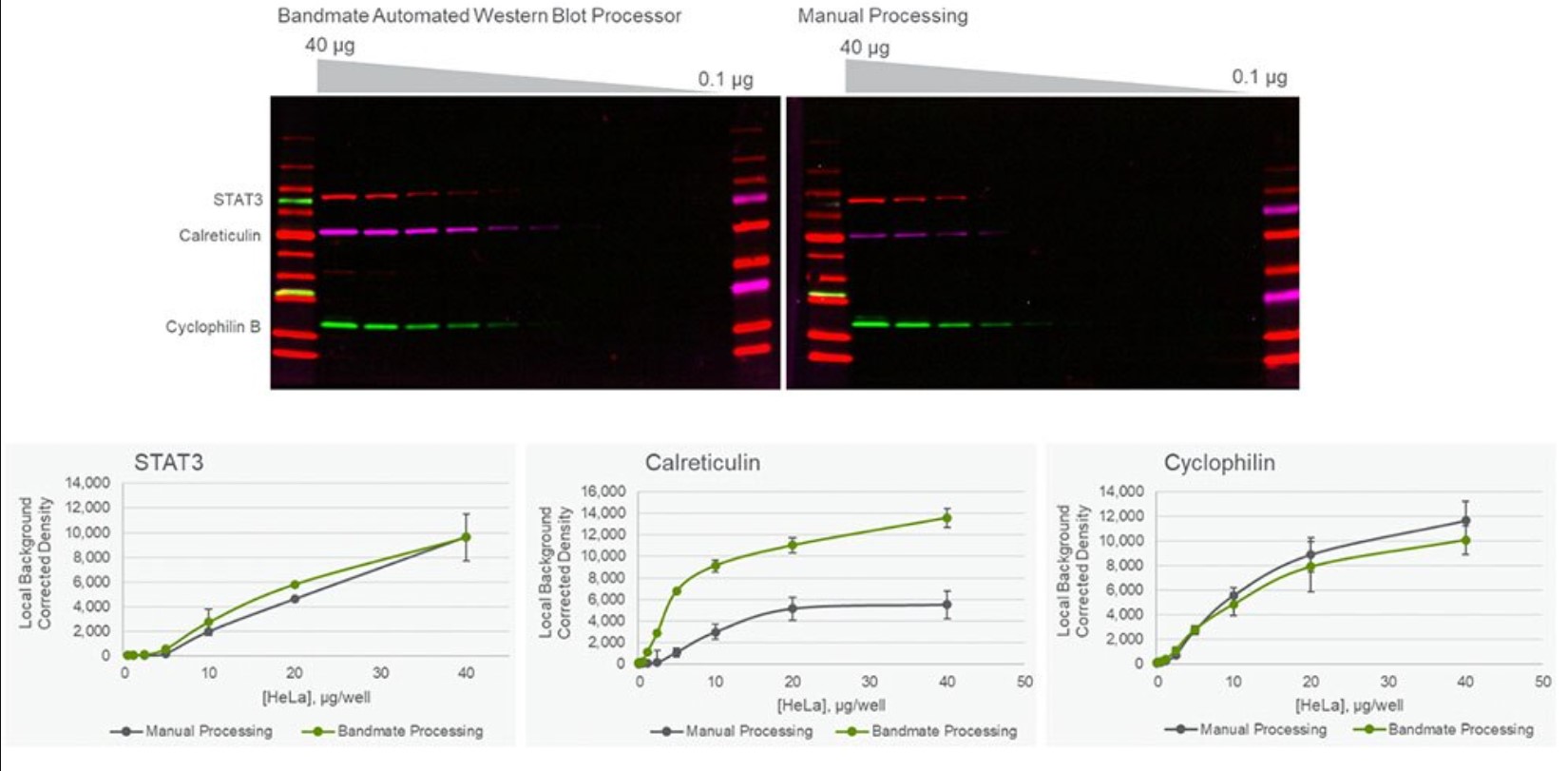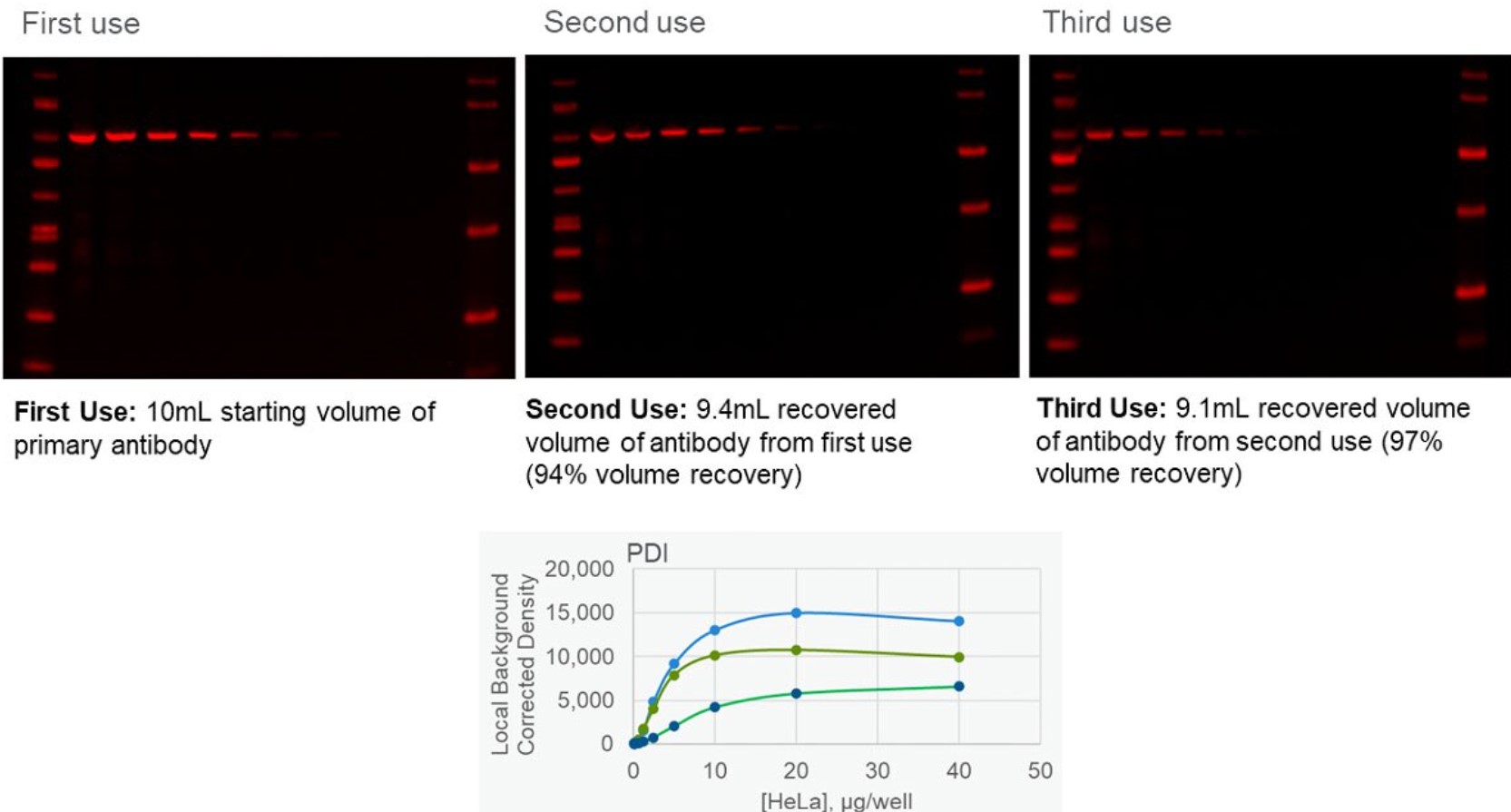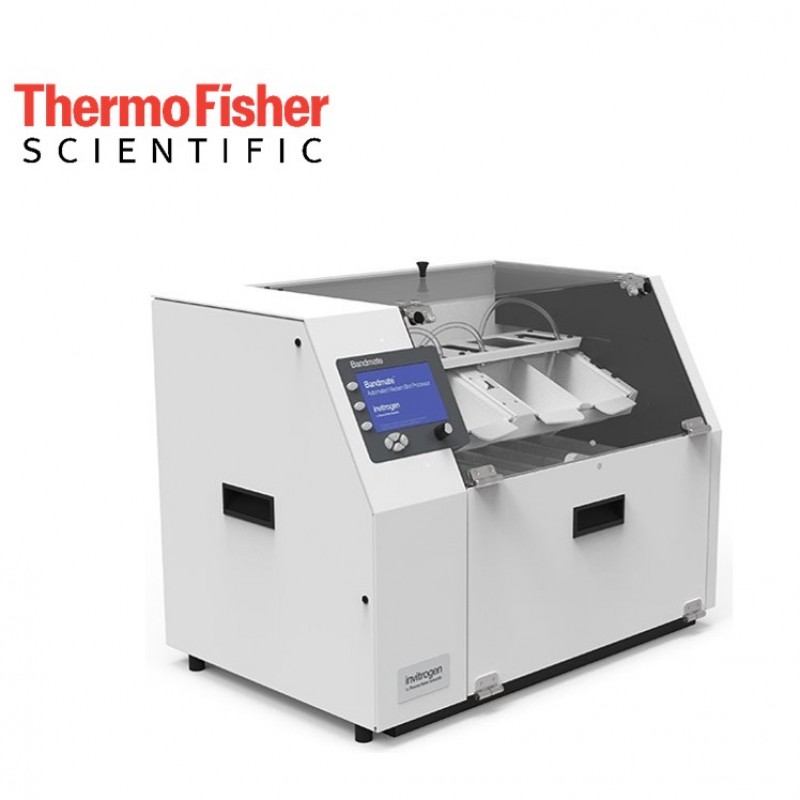Automated Western Blot Processing
The western blot processing procedure is a hands-on, laborious process involving multiple rounds of washes and antibody incubations. With so many steps, its challenging to focus on other work or experiments while processing a western blot, especially if processing several blots at a time. Often, a specific protocol and reagents are optimized for a protein of interest. The Bandmate Automated Western Blot Processor requires no special reagents and is programmable to match your current western blotting protocols. Minimal effort is required to setup the Bandmate device to process up to four blots using your current reagents and protocols for blot processing, but with much less hands-on time.

With simple and reliable operation, program the timing of incubation steps as you would normally, including adjustments for:
- Dispensing volumes - up to 75 mL (for mini blots), and up to 150 mL (for midi blots); programmable with up to 10 repetitions per step
- Rocking speeds - from 5 to 40 cycles per minute
- Incubation times - from 1 minute to 96 hours for blots that may require overnight or longer incubations
- Processing temperatures - the system can be placed in a 4°C cold room if necessary—no special reagents are required
The mini blots processed with the Bandmate Automated Western Blot Processor show comparable intensity levels across multiple probed targets compared to the blots processed with a manual processing procedure.

The midi blots processed with the Bandmate Automated Western Blot Processor show comparable intensity levels across multiple probed targets compared to the blots processed with a manual processing procedure.

Consistency Day-to-Day and Person-to-Person
Maintaining the precise timing of block, wash, and antibody incubation steps can be challenging from blot-to-blot. Because the processing steps of the Bandmate system are programmable, the precision of the steps can be improved compared to manual hands-on western blot processing. With more precision, the consistency from experiment to experiment should also be improved for more reliable results.

The detection of proteins is consistent from blot-to-blot when blots are processed with the Bandmate Automated Western Blot Processor. A 2-fold dilution series of HeLa cell lysate starting at 1.0ug/µL was prepared, loaded onto a Novex 4-20% Tris-Glycine gel (WXP42012BOX), and electrophoresed at 225V for approximately 40minutes. Gels were transferred to nitrocellulose membranes using iBlot™ 2 Transfer Stacks (Cat. No. IB23002). Four blots were processed using the Bandmate Automated Western Blot Processor following a preset protocol. The blots were blocked in 1X Blocker FL Fluorescent Blocking Buffer (Cat. No. 37565). The blots were probed with a mixture of primary antibodies diluted in 1X Blocker FL Fluorescent Blocking Buffer at the following concentrations: Rabbit Anti Hsp90 (1:5000) (Cat. No. PA1-013), Chicken anti-Calreticulin (1:4000) (Cat. No. PA1-903) and Mouse Anti P23(1:1000) (Cat. No. MA3-414). This was followed by an incubation with secondary antibodies diluted at 1:5000 in 1X Blocker FL: Goat anti-Mouse Alexa Fluor Plus 680 (Cat. No. A32729), Goat anti Chicken Alexa Fluor 546 (Cat. No. A11040) and Goat anti Rabbit DyLight 800 4XPEG (Cat. No. SA5-35571). Blots were imaged on the iBright FL1500 Imaging System..
Helps Save Precious Antibodies
With the Bandmate system, one can use as little as 3.5 mL of primary and secondary antibody solutions for mini blots or 7.5 mL of primary and secondary antibody solutions for midi blots with minimal impact to sensitivity of detection.

The Bandmate Automated Western Blot Processor can be effective with as low as 3.5mL of primary antibody per mini blot or 7.5 mL per midi blot without a significant loss in sensitivity of detection. A 2-fold dilution series of HeLa cell lysate starting at 4.0 µg/mL was prepared, loaded onto a Bolt 4-12% Bis-Tris-Plus gel (NW04122BOX) for mini gels and NuPAGE 4-12% Bis-Tris-Plus gel (WG1401BOX) for midi gels, and electrophoresed at 200V for approximately 22 minutes. Gels were transferred to nitrocellulose membranes using the Power Blotter System (Cat. No. PB0012) and Power Blotter Select Transfer Stacks (Cat. No. PB3210). To test primary antibody volume efficiency using the Bandmate Automated Western Blot Processor, three different volumes of primary antibody were tested for mini blots (3.5 mL, 5 mL and 10 mL) and two volumes were tested for midi blots (7.5 mL and 15 mL). Blots were processed with adapted protocols for each volume. Blots were blocked in 1X Clear Milk Blocking Buffer (Cat. No. 37587). Blots were probed with a mixture of primary antibodies diluted in 1X Clear Milk Blocking Buffer at the following concentrations: Mouse Anti STAT3 (1:500) (Cat. No. MA1-13042), Mouse Anti PDI (1:2500) (Cat. No. MA3-019), and Rabbit Anti Cyclophilin B (1:1000) (Cat. No. PA1-027A). This was followed by an incubation with secondary antibody Stabilized Goat anti-Rabbit HRP 10 µg/mL (1:500) (Cat. No. 32460) and Stabilized Goat anti-Mouse HRP 10 µg/mL (1:500) (Cat. No. 32430). For chemiluminescence detection, blots were incubated with SuperSignal West Pico Plus Substrate (Cat. No. 34577). Membranes were imaged on the iBright FL1500 Imaging System.
With the Bandmate Automated Western Blot Processor, more than 90% of the starting antibody volume can be collected and recovered for future reuse. However, successive antibody reuses can lead to successive decreases in target detection and should be validated by the end-user (note: the impact on target detection as a result of successive antibody reuses can vary from antibody to antibody).

The Bandmate system offers the ability to capture primary and secondary antibodies after the respective incubation steps, so the antibody solutions can be saved for reuse in future experiments. A 2-fold dilution series of HeLa cell lysate starting at 4.0 µg/µL was prepared, loaded onto a Bolt 4-12% Bis-Tris-Plus gel (NW04122BOX), and electrophoresed at 200V for approximately 22 minutes. Gels were transferred to nitrocellulose membranes using the Power Blotter System (PB0012) and Power Blotter Select Transfer Stacks (Cat. No. PB3210). To test the accuracy of antibody recovery and efficiency of detection, the Bandmate Automated Western Blot Processor protocol was set up to recover the primary antibody, and the same antibody was used three times. Blots were blocked in 1X Clear Milk Blocking Buffer (Cat. No. 37587), probed with Mouse Anti PDI (1:2500) (Cat. No. MA3-019) diluted in 1X Clear Milk Blocking Buffer. This was followed by an incubation with secondary antibody Goat anti-Mouse Alexa Fluor Plus 680 (Cat. No. A32729) diluted at 1:5000 in 1X TBST. Blots were imaged on the iBright FL1500 Imaging System.
How Bandmate Western Blot system works?
Blocking buffer, wash buffer, and antibody solutions can be prepared as one would normally. Once the solutions are prepared, the wash buffer must be added to a wash buffer reservoir bottle which will dispense the required volumes of wash buffer throughout the processing procedure. Next, antibody solutions are loaded into Bandmate Reagent Tubes (minimum volume of 3.5 mL of primary and secondary antibody solutions for each mini blot or 7.5 mL for each midi blot).

Then, the blot membranes are placed in individual sample trays, which are supported by rocker cradle frames. Blocking buffer is added directly to each tray. If antibody recovery is desired after incubation steps, antibody recovery tubes (50 mL conical tubes) can be inserted on each side of the waste trays to capture both primary and secondary antibody separately. Once the Bandmate device is setup with the necessary reagents for processing, pre-programmed protocols, stored custom protocols, or newly created custom protocols can be utilized. After the program is set, all processing steps are performed in a synchronized manner without further input needed – set up and walk away.
As the protocol proceeds, the sealed-bottom Bandmate Reagent Tubes are punctured to deliver antibody directly to the processing trays. The reagent tubes move in and out of place when necessary via the reagent slider bar. After incubation, antibody can be sent to waste or funneled into antibody recovery tubes (if recovering antibody for future experiments is desired) via the waste and recovery funnel tray. With this unique dispensing system, antibodies are not passing through any fixed tubing, minimizing potential cross-contamination.
The Bandmate processor provides a consistent rocking motion during incubation and wash steps. The rocking motion combined with the unique curved incubation trays helps minimize the required antibody volumes.
The Bandmate processor can be set up to run at room temperature or in a cold room overnight. For convenience, the final wash buffer is held in the processing tray and the rocking motion is maintained so blots remain saturated and ready for the detection step as soon as you are ready. The Bandmate processor comes with everything needed to process up to 4 mini blots or 2 midi blots at the same time. The only required consumables are the Bandmate Reagent Tubes which are changed with each processing experiment.
For more information please click.







